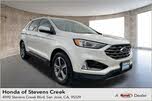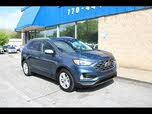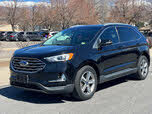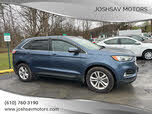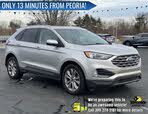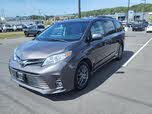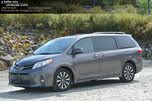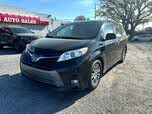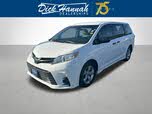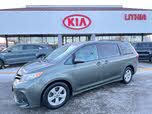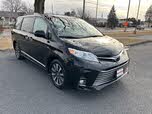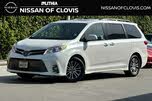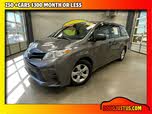2019 Ford Edge vs 2020 Toyota Sienna
Overview | ||
MSRP | $29,995 | $29,715 |
Average price | $17,725 | $30,337 |
Listings | ||
Ratings & Reviews | ||
User reviews | ||
Expert reviews | 7.3 out of 10Read full review | 7.8 out of 10Read full review |
Pros & cons | Pros
| |
Summary | The Edge was a key vehicle in the evolution of the family SUV market when Ford first introduced it for the 2007 model year. Back then, automakers were experimenting with just what a “crossover” could constitute—look at the Pontiac Aztec and first-generation Chrysler Pacifica if you disagree. But with the Edge, the midsize, two-row SUV template started to take shape. Ford offers the 2019 Edge with an ST trim, grafting performance onto the utilitarian Edge blueprint. But that begs a question—can a vehicle still be good at family hauling and commuting while also delivering speed and performance? | Since the second half of the 20th century, each decade has had a hot-topic family car, and, as we’ve noted in a number of reviews this year, the crossover is our current darling vehicle. Before the crossover, there were big, truck-based SUVs. Before that, there were station wagons. And for the past 35 years, there's always been the minivan. The Dodge Caravan has been widely considered the Patient Zero of the minivan segment. From there, seemingly everyone joined the party, including Toyota, Nissan, Ford, Chevy, GMC, Volkswagen, Oldsmobile, Ford, and more. Heck, even Mercury had a “Nautica Edition” version of the Villager. The minivan was king once, the crossover is king now, and some other type of vehicle will likely dominate in the near future. But in all this, the 7- and 8-passenger minivans will always represent the ultimate in versatility. The crossover is an image-forward fad with a dash of usability, but the minivan continues to prove itself as the pinnacle of practicality. The 2020 Toyota Sienna is neither the newest nor flashiest minivan out there, but when you absolutely need space for people and gear, there’s nothing better. Additionally, the Sienna is the only minivan to offer all-wheel drive (AWD), which is something specifically desired by many car buyers. |
Video | ||
Popular Features & Specs | ||
Engine | 2.0L 250 hp I4 | 3.5L 296 hp V6 |
Drive Train | FWD | FWD |
Seating Capacity | 5 | 2 |
Horsepower | 250 hp @ 5500 rpm | 296 hp @ 6200 rpm |
MPG City | 22 | 19 |
MPG Highway | 29 | 26 |
Engine | ||
Engine Name | 2.0L 250 hp I4 | 3.5L 296 hp V6 |
Torque | 280 lb-ft @ 3000 rpm | 263 lb-ft @ 4700 rpm |
Horsepower | 250 hp @ 5500 rpm | 296 hp @ 6200 rpm |
Drivetrain | FWD | FWD |
Fuel Economy | ||
MPG City | 22 | 19 |
MPG Highway | 29 | 26 |
Interior | ||
Seating Capacity | 5 | 2 |
Safety | ||
Front Crash Overall | 5 | 4 |
Side Crash Overall | 5 | 5 |
Dimensions & Capacity | ||
Cargo Space | 39.2 cu ft | |
Curb Weight | 4027 lbs | 4375 lbs |
Height | 68.3 in | 68.9 in |
Length | 188.8 in | 200.2 in |
Width | 85.8 in | 78.1 in |
Wheelbase | 112.2 in | 119.3 in |
Maximum Payload | 1243 lbs | |
Number of doors | 4 | 4 |
Maximum Towing Capacity | 1500 lbs | |
CarGurus highlights

According to CarGurus experts, the overall rating for 2019 Ford Edge is 7.3 out of 10, while the 2020 Toyota Sienna scores 7.8 out of 10. Based on these ratings, the 2020 Toyota Sienna is the recommended choice, offering superior form and function, technology, and safety features, making it a versatile and family-friendly option.
Choose the 2019 Ford Edge if:
Shop Now- You prioritize performance and handling, as the Edge offers a turbocharged 4-cylinder engine for non-ST trims and a powerful 2.7-liter EcoBoost V6 engine for the ST.
- You seek a spacious and versatile cabin with comfortable front seats and ample cargo space.
- You value a range of standard and available features, including Ford’s Co-Pilot360 suite of driver-assistance features.
Choose the 2020 Toyota Sienna if:
Shop Now- You prioritize cargo space and versatility, as the Sienna offers class-leading cargo space of 150 cubic feet.
- You need a family-friendly vehicle with standard safety features, including lane-departure warning, lane-keep assist, and forward-collision warning and avoidance with pedestrian detection.
- You seek a minivan with standard tech features, such as a 7-inch touchscreen infotainment system with Amazon Alexa and Apple CarPlay support.

By: CarGurus + AI
At CarGurus, our team of experienced automotive writers remain at the heart of our content operation, conducting hands-on car tests and writing insightful guides that are backed by years of industry experience. To complement this, we are harnessing AI to make our content offering more diverse and more helpful to shoppers than ever. To achieve this, our AI systems are based exclusively on CarGurus content, ratings and data, so that what we produce is both unique to CarGurus, and uniquely helpful to car shoppers.



















